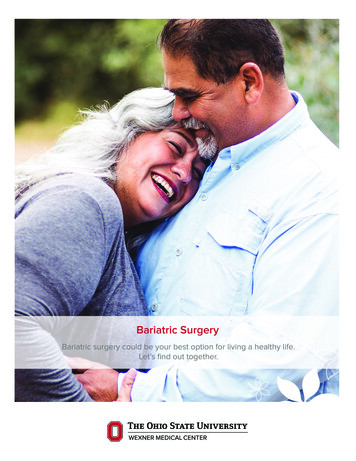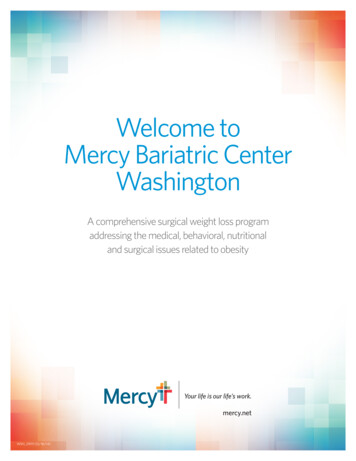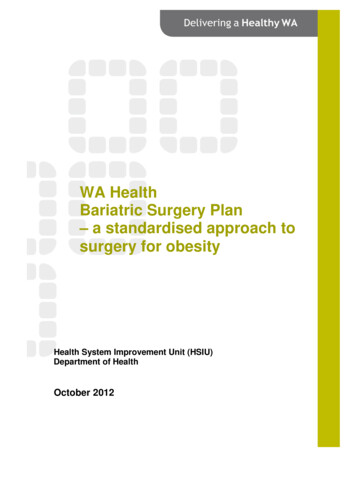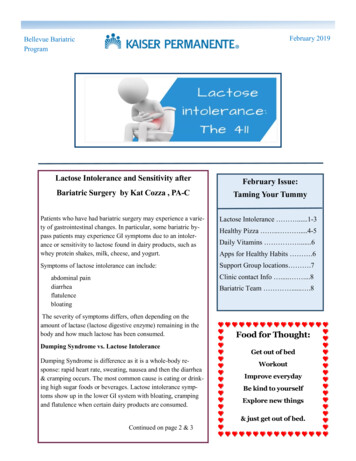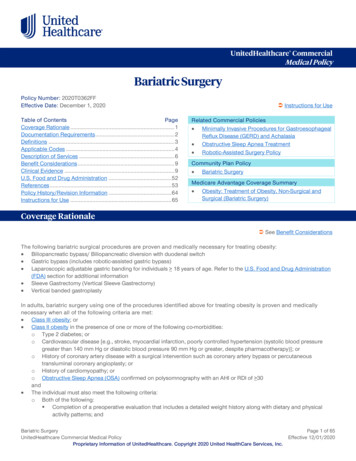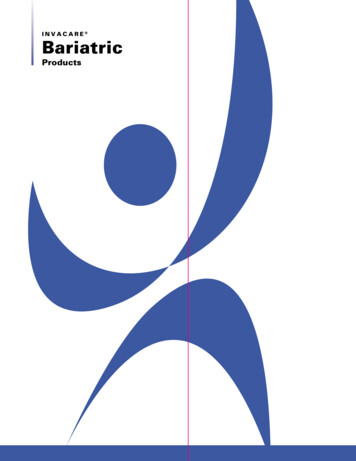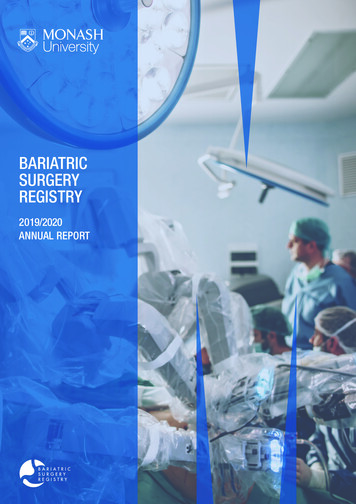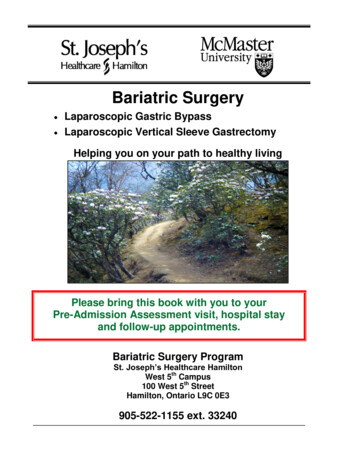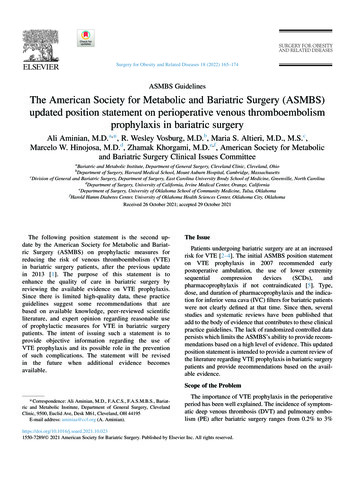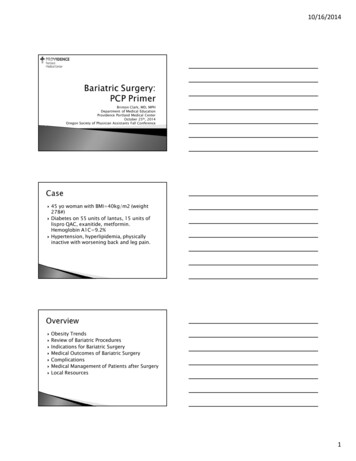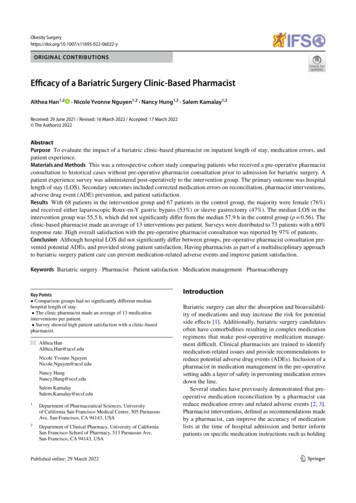
Transcription
Obesity RIGINAL CONTRIBUTIONSEfficacy of a Bariatric Surgery Clinic-Based PharmacistAlthea Han1,2· Nicole Yvonne Nguyen1,2 · Nancy Hung1,2 · Salem Kamalay1,2Received: 29 June 2021 / Revised: 16 March 2022 / Accepted: 17 March 2022 The Author(s) 2022AbstractPurpose To evaluate the impact of a bariatric clinic-based pharmacist on inpatient length of stay, medication errors, andpatient experience.Materials and Methods This was a retrospective cohort study comparing patients who received a pre-operative pharmacistconsultation to historical cases without pre-operative pharmacist consultation prior to admission for bariatric surgery. Apatient experience survey was administered post-operatively to the intervention group. The primary outcome was hospitallength of stay (LOS). Secondary outcomes included corrected medication errors on reconciliation, pharmacist interventions,adverse drug event (ADE) prevention, and patient satisfaction.Results With 68 patients in the intervention group and 67 patients in the control group, the majority were female (76%)and received either laparoscopic Roux-en-Y gastric bypass (53%) or sleeve gastrectomy (47%). The median LOS in theintervention group was 55.5 h, which did not significantly differ from the median 57.9 h in the control group (p 0.56). Theclinic-based pharmacist made an average of 13 interventions per patient. Surveys were distributed to 73 patients with a 60%response rate. High overall satisfaction with the pre-operative pharmacist consultation was reported by 97% of patients.Conclusion Although hospital LOS did not significantly differ between groups, pre-operative pharmacist consultation prevented potential ADEs, and provided strong patient satisfaction. Having pharmacists as part of a multidisciplinary approachto bariatric surgery patient care can prevent medication-related adverse events and improve patient satisfaction.Keywords Bariatric surgery · Pharmacist · Patient satisfaction · Medication management · PharmacotherapyKey Points Comparison groups had no significantly different medianhospital length of stay. The clinic pharmacist made an average of 13 medicationinterventions per patient. Survey showed high patient satisfaction with a clinic-basedpharmacist.* Althea HanAlthea.Han@ucsf.eduNicole Yvonne NguyenNicole.Nguyen@ucsf.eduNancy HungNancy.Hung@ucsf.eduSalem KamalaySalem.Kamalay@ucsf.edu1Department of Pharmaceutical Sciences, Universityof California San Francisco Medical Center, 505 ParnassusAve, San Francisco, CA 94143, USA2Department of Clinical Pharmacy, University of CaliforniaSan Francisco School of Pharmacy, 513 Parnassus Ave,San Francisco, CA 94143, USAIntroductionBariatric surgery can alter the absorption and bioavailability of medications and may increase the risk for potentialside effects [1]. Additionally, bariatric surgery candidatesoften have comorbidities resulting in complex medicationregimens that make post-operative medication management difficult. Clinical pharmacists are trained to identifymedication-related issues and provide recommendations toreduce potential adverse drug events (ADEs). Inclusion of apharmacist in medication management in the pre-operativesetting adds a layer of safety in preventing medication errorsdown the line.Several studies have previously demonstrated that preoperative medication reconciliation by a pharmacist canreduce medication errors and related adverse events [2, 3].Pharmacist interventions, defined as recommendations madeby a pharmacist, can improve the accuracy of medicationlists at the time of hospital admission and better informpatients on specific medication instructions such as holding13Vol.:(0123456789)
Obesity Surgeryor stopping medications prior to surgery. Medication reconciliation ensures appropriate medication managementthrough the process of creating an accurate list of all medications that a patient is taking and comparing that list againsta provider’s medication orders throughout all of a patient’stransition points within the hospital. Without thorough medication reconciliation in the clinic setting, medication issuesare often deferred to the time of admission, when resourcesand time may be constrained. Additional issues may ariseat the time of discharge, requiring urgent and potentiallysuboptimal medication changes and extra time counselingpatients, further delaying time of discharge.Despite the potential role of pharmacists in bariatricpatient management and the value of pre-operative pharmacist interventions, there is currently limited literature available to describe pharmacists’ role in the pre-operative settingfor this patient population. For context, our institution is atertiary medical center based in the USA. The clinical pharmacists at our institution provide recommendations for therapy management to prescribers, and design post-operativemedication therapy plans. While the clinical pharmacistsdo not directly prescribe, as a part of the collaborative careteam, licensed prescribers implement the recommendations.The objective of this study is to evaluate the impact of a preoperative pharmacist consultation in the bariatric surgeryclinic at our medical center.Material and MethodsStudy DesignIn 2018, a clinical pharmacist was integrated into the bariatric surgery clinic to provide medication consultation aspart of every patient’s pre-operative clinic evaluation. Eachpatient was scheduled for a one-time 30- to 60-min meetingwith the pharmacist prior to meeting with the surgeon. Theclinic pharmacist obtained medication histories and providedrecommendations to the patient and the team regarding perioperative medication management. The pre-operative pharmacist resolved any potential medication-related problemssuch as those that arise due to medication absorption afterbariatric surgery. Additionally, the pre-operative pharmacistprovided medication education to the patient.This retrospective cohort study compared the hospitallength of stay (LOS) between patients counseled by a preoperative pharmacist and those who did not. These represent the intervention and control groups, respectively. Secondary measures included corrected medication errors onreconciliation, pharmacist interventions, ADE prevention,and patient satisfaction. The number of corrections to theprior-to-admission (PTA) medication list and types of interventions made by the pharmacist, including those involving13high-risk medications, was evaluated. High-risk medicationswere defined as medications deemed by the study team tohave a high potential to cause adverse effects after bariatricsurgery. For example, insulin can cause hypoglycemia afterbariatric surgery if not properly adjusted.To evaluate patient satisfaction, a 5-item patient experience survey was administered to patients with a pre-operative pharmacist consultation using a 5-point Likert-typeresponse scale (strongly agree, agree, neutral, disagree,strongly disagree). Surveys were distributed in-person, viatelephone, and online as a Qualtrics survey form. Study personnel and clinic staff were utilized to consent patients andprovide the self-administered survey. Patients were askedhow likely they were to agree with the following statements:1. The clinic pharmacist came up with a clear plan for managing my medications after surgery.2. The pharmacist was knowledgeable about my medications.3. The pharmacist answered all of my medication-relatedquestions.4. After speaking with the clinic pharmacist, I felt preparedto manage my medications after surgery.5. Overall, I was satisfied with my visit with the clinicpharmacist.This study was approved by our institutional reviewboard.Study PopulationFor the retrospective cohort study, inclusion criteria wereadults that were admitted for primary bariatric surgerybetween January 2015 and October 2018. We excludedpatients with concomitant surgeries other than a cholecystectomy. Historical cases were randomly selected andassessed for eligibility. For the patient experience survey,all patients who had a pre-operative pharmacist consultationwere eligible.Statistical AnalysisThe Wilcoxon rank-sum test was used for the primary analysisof LOS. An estimated total sample size of 126 patients wasneeded to achieve 80% power to detect a difference in LOSof 0.25 days or 6 hours. Given the fact that these patientsfollowed a bariatric pathway that standardizes discharge onpost-operative day (POD) 2, we opted to detect a difference inhours instead of days. A 6-hour difference in LOS was acceptable in significance due to the logic that it would increase thenumber of patients discharged by noon, which is a goal atour institution to facilitate bed control. We chose to combineprocedure types when calculating the sample size because
Obesity Surgerythe bariatric pathway implemented during the study periodproposed discharge on POD2 regardless of whether a patientunderwent Roux-en-Y gastric bypass (RYGB) or sleeve gastrectomy. The chi-squared test was used for categorical dataand the unpaired t-test or Wilcoxon rank-sum test was used forcontinuous data as appropriate. Analyses were performed withan a priori significance level of 0.05. All statistical analyseswere performed with Stata, version 15.0.ResultsOf 165 patients that were assessed for eligibility, 30 had concomitant surgeries and were therefore excluded, leaving 135patients available for analysis. Of these, 68 patients receivedpre-operative pharmacist counseling and were categorized asthe intervention group. The remaining 65 patients comprisedthe control group (Fig. 1).At baseline, the two groups did not have significant differences (Table 1). The study population had a mean age of48.3 (SD 11.9) and were predominantly female (76%). Thetwo comparison groups were split relatively evenly into twotypes of bariatric surgeries: Roux-en-Y gastric bypass (53%)or sleeve gastrectomy (47%).For the primary outcome of hospital LOS, the difference was not statistically significant between the comparison groups (Fig. 2). The intervention group had a medianLOS of 55.5 h and the control group had a median of 57.9 h(p 0.56). There was no statistically significant differencein hospital LOS by procedure type.As part of the medication reconciliation process, corrections to the PTA medication list were made by the clinicpharmacist for 61 patients (90%) in the intervention group.The pharmacist made a median of 4 corrections per patient.Types of corrections included adding missing medications(93%), removing old medications (52%), updating missingor incorrect medication details (48%), and removing duplicate medications (5%).More of the intervention group reported taking high-riskmedications at baseline (73%) compared to the control group(63%). Some of the most common high-risk medicationswere non-steroidal anti-inflammatory drugs (NSAIDs), insulin, opioids, sleep aids (such as trazodone and Z-hypnotics),aspirin, benzodiazepines, and skeletal muscle relaxants(Fig. 3).The pharmacist made a median of 13 interventionsper patient in the pre-operative clinic consultation. Theseincluded recommendations for medication managementboth before and after surgery (Table 2). Pharmacist interventions for pre-operative management included dose changes,medication tapers, pregnancy prevention counseling, perioperative anticoagulation planning, and smoking cessationcounseling. All patients were counseled on new medicationsthat would be prescribed after surgery.Surveys were offered to all patients who received a preoperative pharmacist consultation, including 5 patients whodid not meet inclusion criteria and were not included in theintervention group of the primary analysis. Therefore, a totalof 73 patients received the survey. The self-administeredpatient experience survey response rate was 60%. Surveymethods included paper (22), phone (18), and internet survey (4). Over 90% of respondents strongly agreed or agreedto the benefits of an in-clinic pharmacist consultation inthe areas of pharmacist clarity, pharmacist answer quality,pharmacist helpfulness, self-preparedness, and overall satisfaction. When asked about overall satisfaction with thepharmacist consultation, 97% of patients reported “stronglyagree” or “agree.” Patients’ descriptive comments regarding the pre-operative pharmacist consultation were all positive—samples of quoted comments included: “Discharge instructions were well laid out which was appreciated”“Knowledgeable and thorough consultation”“Well prepared pharmacist”“Satisfied with care and all questions were answered”“Very helpful to have access to answer questions”DiscussionHospital Length of StayFig. 1 Patient group assignments: all patients meeting inclusion criteria were assigned to either intervention group or control group basedon whether or not they received pre-operative pharmacist consultationAlthough the primary outcome of hospital LOS was not significantly different between groups, the intervention grouphad less variability in LOS, as shown in the box plot ofFig. 2. This may be attributed to a more efficient dischargeprocess after implementation of a pre-operative pharmacist consultation. In the intervention group, patients were13
Obesity SurgeryTable 1 Baseline characteristicsat time of surgeryMeasureControl, n 67Intervention, n 68Age (years), mean (SD)Weight (kg), mean (SD)Calculated BMI (kg/m2), median (IQR)ASA category, median (IQR)Calculated length of surgery (min), median (IQR)By sleeve gastrectomyBy Roux-en-Y gastric bypassLaparoscopic, n (%)Robot-assisted, n (%)SurgeonSurgeon A, n (%)Surgeon B, n (%)Surgeon C, n (%)Surgery: sleeve gastrectomy, n (%)Roux-en-Y gastric bypass, n (%)Discharge day of week: weekday, n (%)Year of surgery2015, n (%)2016, n (%)2017, n (%)2018, n (%)ComorbiditiesDocumented infection within 30 days post-op, n (%)Diabetes, n (%)Hypertension, n (%)Sleep apnea, n (%)Bleeding disorders, n (%)Chronic renal disease, n (%)Hemodialysis, n (%)Chronic liver disease, n (%)Heart failure, n (%)MI/stroke/PVD, n (%)Chronic pain, n (%)Pre-transplant, n (%)History of transplant, n (%)47.7 (12.3)120.3 (21.4)41.8 (39.7, 46.8)3.0 (2.0, 3.0)116.0 (92.0, 153.0)92.0 (76.0, 104.0)151.0 (121.0, 180.0)67 (100%)4 (6%)48.9 (11.6)122.1 (22.6)41.7 (38.6, 47.4)3.0 (2.0, 3.0)107.5 (81.0, 135.0)81.0 (73.0, 97.0)141.0 (126.0, 163.0)68 (100%)4 (6%)24 (36%)24 (36%)19 (28%)34 (51%)33 (49%)35 (52%)26 (38%)23 (34%)19 (28%)29 (43%)39 (57%)31 (46%)22 (33%)22 (33%)23 (34%)0 (0%)0 (0%)0 (0%)0 (0%)68 (100%)9 (13%)23 (34%)36 (54%)27 (40%)1 (1%)5 (7%)2 (3%)2 (3%)2 (3%)1 (1%)38 (57%)2 (3%)4 (6%)6 (9%)27 (40%)41 (60%)35 (51%)1 (1%)5 (7%)3 (4%)5 (7%)5 (7%)3 (4%)35 (51%)5 (7%)4 (6%)Abbreviations: BMI body mass index, ASA American Society of Anesthesiologists, IQR interquartilerange, MI myocardial infarction, PTA prior to admission, PVD peripheral vascular disease, SD standarddeviationcounseled extensively prior to surgery on how to managetheir medications before and after surgery. The medicationmanagement plans were established and discussed prior tohospital admission. This helped to minimize the time spentduring the hospital stay to address medication-related issues.However, there are various factors that could impact thehospital LOS after bariatric surgery as reported in currentliterature. Major et al. [4] found risk factors for prolongedLOS (defined as LOS greater than 3 days) among bariatric patients including low oral fluid intake, high volume ofintravenous fluids after surgery, and hospital distance fromresidence. Mahmood et al. [5] reported sleeve gastrectomy13procedure type and pre-operative body mass index (BMI)greater than 50 kg/m2 were associated with LOS greater than1 day. Our study did not evaluate the same risk factors asMajor et al., and we did not find high BMI or procedure typeto be significant contributors to prolonged LOS.Medication List ErrorsDespite the lack of a significant difference in the primaryoutcome between comparator groups, there was a large percentage (90%) of patients with medication errors identifiedand corrected in the pre-operative pharmacist consultation.
Obesity Surgeryconsultations, 81.5% of which were pre-operative consultations, where pharmacists provided an average of 8 medication recommendations per patient. Our study reported ahigher median 13 interventions per patient, which may beexplained by differences in patient characteristics. Additionally, Silverman et al. [8] reported 98% of pharmacistrecommendations were approved by surgeons. This studydid not measure the percentage of pharmacist interventionsaccepted, but pharmacist recommendations are generallywell received based on our experience.High-Risk MedicationsFig. 2 Boxplot of hospital length of stay by group: distribution ofhospital length of stay in hours between intervention group and control groupAn example of a key pharmacist intervention is educationon the risks of NSAIDs, which is an established cause ofpeptic ulcer disease and has also been reported to be associated with marginal ulcer disease after bariatric surgery [6,7]. Lower rates of NSAID use at the time of surgery amongpatients in the intervention group compared to the controlgroup may reflect the impact of pre-operative pharmacisteducation on the risk of post-operative NSAID use.Only one study was found in the current literaturedescribing similar interventions via pre-operative pharmacistconsultation. Silverman et al. [8] described 124 pharmacistThe clinic pharmacist provided additional benefit to patientsthrough recommendations aimed at minimizing potentialADEs from high-risk medications.Using benzodiazepine (BZD) tapers as an example,many clinicians elect to discontinue BZDs after bariatric surgery since this population is susceptible to druginduced respiratory depression. The risk of respiratorydepression is further increased considering most postoperative patients utilize opioids for pain control. Discontinuation of BZDs can be particularly concerning forchronic BZD users given the risk of withdrawal if notproperly tapered. BZD tapers over a 4- to 6-week periodare generally recommended to minimize withdrawal,which require pre-operative planning and management [9].In our intervention group, the clinic pharmacist identifieduse early on and provided appropriate taper recommendations prior to surgery.Fig. 3 Types of high-riskPTA medications: proportionof historical control cases (inblue) and intervention group (inorange) with high-risk medications listed on their PTA medication list. For the interventiongroup represented in this figure,high-risk medications are basedon updated medication listsafter the clinic pharmacist’smedication reconciliation13
Obesity SurgeryTable 2 Types and total countof pharmacist interventionsat time of consultation in theintervention group (n 68)Pre-operative managementPost-operative management Dose change: 11 (16%) Taper: 9 (13%) Other interventionsa: 8 (12%) Monitoring: 7 (10%) New medication counseling: 68 (100%) Admin instruction change: 58 (85%) Hold medication until follow-up: 53 (78%) Agent change: 45 (66%) Discontinue medication: 41 (60%)aOther interventions: pregnancy prevention counseling (e.g., birth control, barrier method), anticoagulationplanning, smoking cessation counselingEstrogen-containing therapies were another examplewhere pharmacists intervened peri-operatively in this study.Exogenous estrogen is a known risk of venous thromboembolism (VTE), which is the leading cause of mortality afterbariatric surgery [10]. Additional VTE risk is avoidable:pharmacist intervention can play a crucial role in preventing VTE-related mortality by minimizing peri-operative useof prothrombotic medications like estrogen.Patient Experience SurveyPatients in this study reported high satisfaction with thepre-operative pharmacist consultation, which is consistentwith surveys regarding similar pharmacy services reportedin the literature. In a patient experience survey of patientswho received pharmacist-directed anticoagulation services(n 159), Makowski et al. [11] reported significant increase inamount of information, clarity of information, answer quality,and overall satisfaction compared to those who were managedmainly by their primary care team (n 528). Graham et al. [12]similarly reported high patient satisfaction with pre-operativepharmacist consultation prior to bariatric surgery (n 40),where patients identified pharmacists as particularly helpfulin preparing them for medication changes after surgery.Limitations of the StudyThis study’s power estimation for the primary outcome ofhospital LOS was not based on data reported in the literaturedue to a wide range of LOS reported after bariatric surgery.The heterogenic reporting of LOS may be in part due to differences in surgeon practices and protocols at each bariatriccenter and advances in practices over time. The time periodreviewed in this study was thought to be close enough thatpractices did not significantly differ. However, a larger sample size may be needed to evaluate the effect of pharmacistintervention on hospital LOS.Another limitation of this study is that while we were ableto characterize medication list corrections and interventionsby the pre-operative clinic pharmacist, we were not able tocompare this to medication list corrections and interventionsmade in the control group during hospitalization. We weretherefore unable to conclude the degree to which the clinic13pharmacist’s contributions were unique and unreproduciblein the inpatient setting. However, as previously outlinedunder sub-section “High-Risk Medications,” it is evidentthat having accurate medication reconciliation early in thecourse of pre-operative planning is critical to addressing andameliorating certain medication-related problems.It should be noted that medications deemed as high-riskwere based on an internal definition; further studies are neededto evaluate long-term adverse outcomes of such medications tobetter categorize high-risk medications after bariatric surgery.Patient satisfaction with the pharmacist consultation wasevaluated only in patients who received a pre-operative pharmacist consultation. Without a comparator group, we canonly say that patients were content with their pre-operativepharmacist consultation. Future studies comparing patientsatisfaction to a control group are needed to ascertain ifinclusion of a pre-operative pharmacist consultation madea relative improvement in patient satisfaction.ConclusionsIn conclusion, although the difference in hospital LOS wasnot statistically significant between patients who receiveda pre-operative pharmacist consultation and controls, thisstudy demonstrated the value of a pre-operative pharmacistconsultation. These benefits included preventing potentialADEs and providing strong patient satisfaction. Futuredirections to consider include evaluating the risk of continuing high-risk medications after bariatric surgery andpharmacoeconomic analysis of pharmacist interventionswith hospital-specific accounting measures.DeclarationsAll procedures performed in studies involving human participantswere in accordance with the ethical standards of the institutional and/or national research committee and with the 1964 Helsinki declaration and its later amendments or comparable ethical standards. Forthe retrospective cohort study: for this type of study, formal consent isnot required. For the patient experience survey: informed consent wasobtained from all individual participants included in the study.Conflict of Interest The authors declare no competing interests.
Obesity SurgeryOpen Access This article is licensed under a Creative Commons Attribution 4.0 International License, which permits use, sharing, adaptation, distribution and reproduction in any medium or format, as longas you give appropriate credit to the original author(s) and the source,provide a link to the Creative Commons licence, and indicate if changeswere made. The images or other third party material in this article areincluded in the article's Creative Commons licence, unless indicatedotherwise in a credit line to the material. If material is not included inthe article's Creative Commons licence and your intended use is notpermitted by statutory regulation or exceeds the permitted use, you willneed to obtain permission directly from the copyright holder. To view acopy of this licence, visit 8.9.References1. Miller AD, Smith KM. Medication and nutrient administrationconsiderations after bariatric surgery. Am J Health-Syst Pharm.2006;63:1852–7.2. Kwan Y, Fernandes OA, Nagge JJ, et al. Pharmacist medicationassessments in a surgical preadmission clinic. Arch Intern Med.2007;167:1034–40.3. Hale AR, Coombes ID, Stokes J, et al. Perioperative medicationmanagement: expanding the role of the preadmission clinic pharmacist in a single centre, randomised controlled trial of collaborative prescribing. BMJ Open. 2013;3(7):e003027.4. Major P, Wysocki M, Torbicz G, et al. Risk factors for prolongedlength of hospital stay and readmissions after laparoscopic sleeve10.11.12.gastrectomy and laparoscopic Roux-en-Y gastric bypass. ObesSurg. 2018;28:323–32.Mahmood F, Sharples AJ, Rotundo A, et al. Factors predicting length of stay following bariatric surgery: retrospectivereview of a single UK tertiary centre experience. Obes Surg.2018;28:1924–30.Chan FKL, Leung WK. Peptic-ulcer disease. Lancet.2002;360:933–41.Coblijn UK, Lagarde SM, de Castro SM, et al. Symptomatic marginal ulcer disease after Roux-en-Y-gastric bypass: incidence, riskfactors and management. Obes Surg. 2015;25:805–11.Silverman JB, Catella JG, Tavakkolizadeh A, et al. Bariatric surgery pharmacy consultation service. Obes Surg. 2011;21:1477–81.Soyka M. Treatment of benzodiazepine dependence. N Engl JMed. 2017;376:1147–57.Morino M, Toppino M, Forestieri P, et al. Mortality after bariatric surgery: analysis of 13,871 morbidly obese patients from anational registry. Ann Surg. 2007;246:1002–9.Makowski CT, Jennings DL, Nemerovski CW, et al. The impactof pharmacist-directed patient education and anticoagulantcare coordination on patient satisfaction. Ann Pharmacother.2013;47:805–10.Graham Y, Callejas-Diaz L, Parkin L, et al. Exploring the patientreported impact of the pharmacist on pre-bariatric surgical assessment. Obes Surg. 2019;29:891–902.Publisher's Note Springer Nature remains neutral with regard tojurisdictional claims in published maps and institutional affiliations.13
Efficacy of a Bariatric Surgery Clinic-Based Pharmacist Althea 1,2Han 1,2· Nicole Yvonne Nguyen1,2 · Nancy Hung1,2 · Salem Kamalay Received: 29 June 2021 / Revised: 16 March 2022 / Accepted: 17 March 2022 . clinic pharmacist obtained medication histories and provided recommendations to the patient and the team regarding peri-
